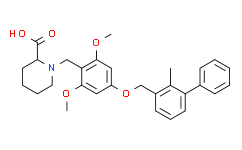| 中文名称: | 阿特珠单抗 | ||||
|---|---|---|---|---|---|
| 英文名称: | Atezolizumab | ||||
| 别名: | 阿特朱单抗;阿特珠单抗 Atezolizumab;Tecentriq | ||||
| CAS No: | 1380723-44-3 | ||||
| CAS No: | 1380723-44-3 | ||||
基本信息
|
产品编号: |
A10976 |
||||
|
产品名称: |
Atezolizumab |
||||
|
CAS: |
1380723-44-3 |
储存条件 |
粉末 |
-20℃ |
四年 |
|
|
|
||||
|
分子式: |
|
溶于液体 |
|
|
|
|
分子量 |
|
|
|
||
|
化学名: |
|
||||
生物活性
|
产品描述 |
一种人源化单克隆抗体 IgG1,抵抗程序性死亡因子配体1 (PD-L1),用于癌症研究。 |
|
靶点 |
hPD-L1 0.4nM(Kd) |
|
体外研究 |
Atezolizumab (anti-PD-L1)的主要特征是,它是一种FcγR结合缺陷的抗体抑制剂,它不能与吞噬细胞上的Fc受体结合,因而不会引起抗体依赖性的细胞毒性(ADCC)。Atezolizumab的处理会引起细胞因子的改变,包括IL-18, IFNγ, CXCL11的瞬时增加和IL-6的瞬时减少。处于增殖状态的CD8+ T细胞数目在atezolizumab处理后会增多。 |
|
体内研究 |
Atezolizumab (anti-PD-L1)通过阻止PD-L1/PD-1免疫检查点,减少肿瘤微环境中的免疫抑制信号,同时增强T细胞介导的对抗肿瘤的免疫反应。最开始对Atezolizumab的药代动力学的研究在cynomolgus monkeys和小鼠中进行,其分布容积约为血浆中体积。给药24小时后,atezolizumab在体内生物分布于脾脏、肾脏、肝脏、心脏和肌肉(按数量级排序)。在携瘤动物中,Atezolizumab也会在肿瘤中积累,最开始是在肿瘤的推挤边界(pushing order),进而向肿瘤核心区域进展,尤其是肿瘤坏死时。Atezolizumab的药代动力曲线是剂量依赖性的(非线性)。给药后24-48小时,当血浆浓度>0.5μg/mL时,循环的CD4和CD8 T细胞中,PD-L1受体被atezolizumab占据饱和。Atezolizumab与PD-L1的结合亲和力在猴子和人类中类似。 |
推荐实验方法(仅供参考)
|
细胞实验: |
Objective: Antibody-dependent cellular cytotoxicity (ADCC) Objective: Determine the binding of [111In]PD-L1-mAb to tumor cell lines
|
|
动物实验: |
Objective: To determine the effect of anti-hPD-L1 antibody on human PD-L1-expressing mouse tumor model Objective: Developed and evaluated radiolabeled [111In] PD-L1-mAb and near-infrared dye conjugated NIR-PD-L1-mAb (Atezolizumab) for non-invasive imaging of PD-L1 expression in tumors |
本计算器可帮助您计算出特定溶液中溶质的质量、溶液浓度和体积之间的关系,公式为:
质量 (g) = 浓度 (mol/L) x 体积 (L) x 分子量 (g/mol)
摩尔浓度计算公式
用本工具协助配置特定浓度的溶液,使用的计算公式为:
开始浓度 x 开始体积 = 最终浓度 x 最终体积
稀释公式
稀释公式一般简略地表示为:C1V1 = C2V2 ( 输入 输出 )










